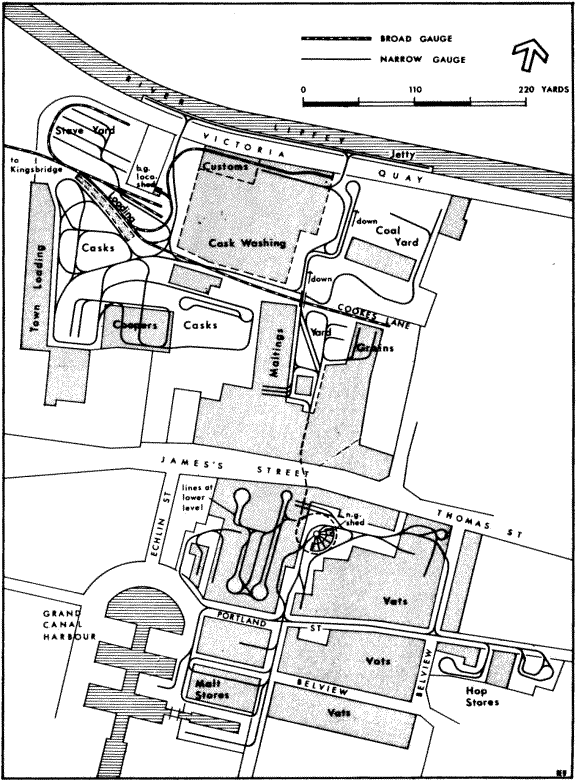
| THE INDUSTRIAL RAILWAY RECORD |
© DECEMBER 1968 |
GUINNESS BREWERY
TRAMWAYS
PAUL ELLISON
The steadily increasing output from Guinness’s Dublin Brewery in the Victorian era had reached such proportions by the 1870’s that the movement of large quantities of heavy and bully raw materials and waste products within the brewery was proving. a serious obstruction to any future projected expansion. The existing methods (horse tramway, and horse and cart were both slow and cumbersome and very inefficient. With the acquisition of land between the existing brewery and the River Liffey, further expansion was able to tale place and some activities previously carried out in the old brewery were transferred there. Moreover, as this land was situated near the Kingsbridge terminus (Great Southern & Western Railway), a direct connection with the Irish railway network could be effected, with barges working to and from a quay on the Liffey.
The solution to the transport problem lay in the construction of a narrow gauge railway network serving the entire brewery. Much of the basic system was laid between 1873 and 1877 under the supervision of Samuel Geoghegan who joined the brewery engineering staff in 1872 at the age of 28 and rose to the position of Head Engineer in 1875. Mr Geoghegan set himself certain limits on the size of the narrow gauge lines and rolling stock. The track gauge was settled at 1ft 10in, the loading gauge was to have a headway of six feet and a maximum width of five feet, and the maximum gradient was to be not steeper than one in forty. A difference in levels of about 50ft existed between the old brewery and the newer land which sloped sharply down to the Liffey, the two areas being separated by James’s Street.
To connect the two halves of the works and overcome the difference in levels, Mr Geoghegan constructed a spiral tunnel in the old brewery and tool the narrow gauge line under James’s Street. The spiral section replaced a short-lived hydraulic lift, a clumsy and slow apparatus which could only manage to tale one wagon at a time, causing trains to be broken up and re-assembled on different levels. The single track spiral tunnel contained the line’s steepest gradient, 1 in 39, and, in 2.65 turns raised the line about 35ft, with a spiral radius of 61.25ft.
The narrow gauge track was largely laid in granite setts, for the benefit of road vehicles in the brewery yards, and this also applied to lines laid on the quay. The permanent way itself, where laid in setts, consisted originally of 56lbs per yard iron tram rails fastened to longitudinal sleepers which were laid on cross sleepers. When laid in concrete the rails were set directly in the ground, using wrought iron cross ties. Later, 76lb steel rails having a web and flange were brought into use, being laid on cross sleepers. Narrow gauge points used the tongued, pointed rail found on many early tramways. Two noteworthy features of the narrow gauge network were the marshalling yard (officially known as No.10 Vathouse Yard in the lower half of the brewery which was still in use in September, 1964, together with the tunnel, and also the quay on the Liffey, started in 1873, but demolished in February, 1963. The quay was extended at various intervals until 1913, but nothing remains of it today.

A few years after the construction of the narrow gauge tramway a broad gauge line was laid to connect the lowest level of the brewery, by the river, with the Kingsbridge goods yard. This line is described in more detail later.
Narrow gauge signalling was by hand or flag as required except at each end of the spiral tunnel, where a simple method of signalling was in operation. This consisted of two interlocked discs, one being suspended at each end of the tunnel. When a driver approached the tunnel and saw the disc at the vertical, or "clear", position, he would proceed and turn the disc to the horizontal, or "line blocked", position as he passed. This automatically caused the disc at the other end of the tunnel to display the same aspect. On leaving the tunnel the driver turned the disc back to the "clear" position.
Regarding the nature of the traffic and method of working, there has never really been a "main line" on the system as trains usually worked short trips on each level or between adjacent levels. On the bottom level narrow gauge trains worked between the broad gauge loading and unloading banks, and the cask washing sheds. Often, more than eight thousand casks could be moved by one train in a single day. 0n the middle level, malt was the chief traffic, trains running between the maltings and the malt store. At the upper and middle levels, trains removed used hops and spent grain to the disposal points, whilst on the upper level malt and hops were taken to the brewhouse. At one time narrow gauge trains also served the jetty, connecting it with the cask cleansing and racking plant.
Two years after construction of the line had started, the first of the narrow gauge locomotives was delivered. This was a small Sharp Stewart 0−4−0 saddle tank costing £445, with inside cylinders (unusual for a narrow gauge locomotive) and numbered 1 in the narrow gauge locomotive stock. It weighed only about two tons and proved to be inadequate for the work. One problem encountered with it was maintenance of the motion, which, being very near the ground, was inaccessible whilst the locomotive was on the road. Later, as more engines appeared on the scene, No.1 was used only for hauling the visitors’ special passenger train, and it was eventually withdrawn from service in 1913.
In the following year, 1876, two locomotives were obtained from Stephen Lewin, of Poole, Dorset, at a cost of £366 each; they carried numbers 2 and 3 and were named HOPS and MALT respectively. These locomotives were geared and had large flywheels, similar to steam rollers. Weighing about five tons each they were more powerful than No.1, but repair costs were heavy owing to a lack of springs. They damaged the track and were slow and troublesome in operation.
1878 saw the arrival of two larger locomotives. These were Sharp Stewart 0−4−0 side tank engines weighing six tons each and having outside cylinders. Although an improvement on the previous locomotives the motion was still near the ground, and these engines were expensive to operate as dirt could, and did, enter the moving parts. However, as they survived until 1925, they must have had a certain measure of success.
None of the first five locomotives being entirely satisfactory, Mr Geoghegan set about designing a locomotive possessing all their best features but without their handicaps. The result was an 0−4−0 side tank engine with horizontally mounted cylinders situated above the marine-type boiler driving through a dummy crankshaft and vertical connecting rods, which in turn drove the wheels. Instead of the cylinders being bolted to the boiler, they were fixed to the frames which were carried the full height of the locomotive above the top of the boiler. The side tanks were also attached to the frames. Another novel feature was the independent spring frame which consisted of eight steel leaves in pairs, two pairs on each side of the locomotive and one pair each above and below the axleboxes. It was attached to the front and back stays, so that by removing the pins and connecting rods, and with the locomotive lifted, the spring frame could be wheeled out from beneath the locomotive to receive attention and maintenance. The general layout of these engines was one of accessibility for repair but with maximum protection from dirt.
The principal dimensions of these locomotives are:
| Cylinders (two) | : | 7in diam x 8in stroke |
| Wheels | : | 1ft 10in diameter |
| Wheelbase | : | 3ft 0in |
| Boiler | : | 2ft 5in inside diameter |
| Boiler tubes | : | 64 x 1½in inside diameter 2ft 103/8in long |
| Boiler pressure | : | 180 lbs per sq in |
| Heating surface | : | 13.75 sq ft
(firebox) 72.61 sq ft (tubes) |
| Fire grate area | : | 3.24 sq ft |
| Capacities | : | 3½ cwts coal 80 galls water |
| Axle loading | : | 3.6 tons leading axle 3.8 tons trailing axle |
| Total weight | : | 7 tons 8 cwts |
| Tractive effort | : | 2,900 lbs |
| Max. loading | : | 75 tons (level track) 18 tons (1 in 40 grade) |
A prototype locomotive was built in 1882 by the Avonside Engine Company, of Bristol, at a cost of £848, and numbered 6 in the locomotive stock, This was also the last of Guinness’s narrow gauge steam locomotives to be built in England, all others being built by William Spence, of the Cork Street Foundry and Engineering Works, in Dublin. This firm built locomotives 7 to 9 in 1887, 10 to 12 in 1891 and 13 to 15 in 1895. A further four, the largest single order for these engines, were turned out in 1902, whilst 20 and 21 were delivered in 1905. 22 entered traffic in 1912 and the last two finally appeared in 1921. No.6 was withdrawn in 1936 but all the others survived the Second World War and lasted until the introduction of diesel locomotives.
Four views of the narrow gauge system:
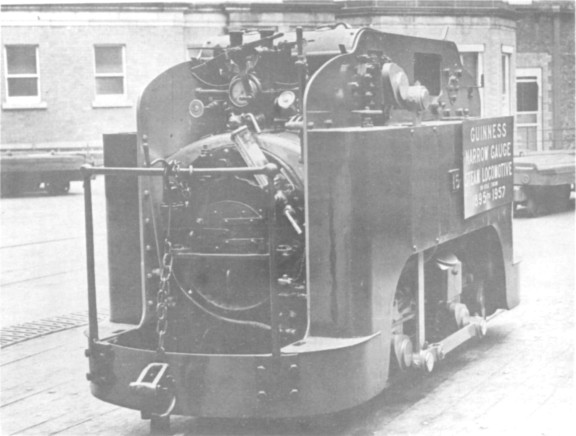
15 preserved (Official photograph).
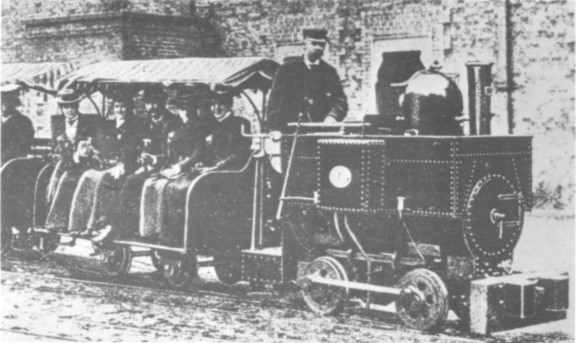
The first locomotive with a visitors’ passenger train (collection F. Jones)
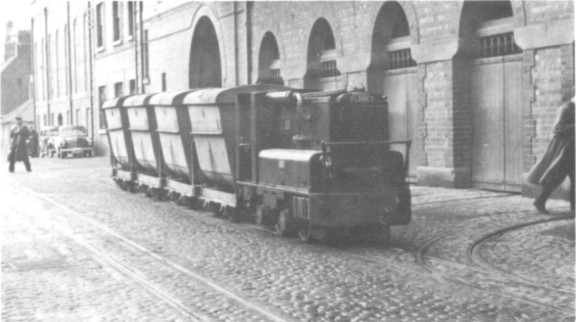
Planet diesel 31 on a train of covered four wheel wagons in October 1955 (L. King).
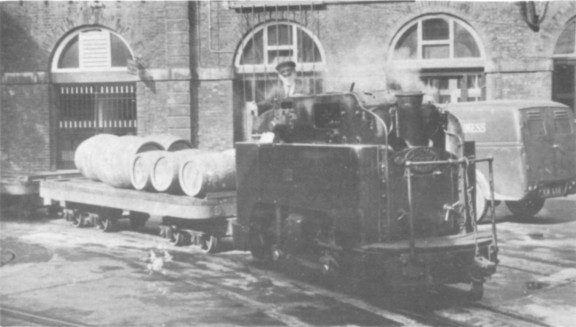
24 with bogie flat in 1956 (R. West).
About 1940 the maintenance of the ageing steam fleet was becoming uneconomic and it was decided to embark on a policy of purchasing diesel locomotives as replacements. The restricted loading gauge and sharp curvature of many of the lines presented many difficulties in design. To meet the necessary requirements a seven ton, 37 horsepower "Planet" diesel locomotive was produced by F.C. Hibberd & Co. Ltd., Park Royal, London. The first example, No.25, was built in 1947, and after trials, Nos.26 to 30 followed in 1948. The other six, Nos.31 to 36, were built in 1950, but No.36 was not delivered until 1951, after spending some months at the Festival of Britain Exhibition in London. By 1964 more than half of the narrow gauge mileage had ceased to function and some of these locomotives were no longer needed. With spare parts for the diesels becoming difficult to obtain, locomotives 28, 30 and 33 were withdrawn from service in 1961. By September 1964, all three were stored in the marshalling yard, looking much the worse for their sojourn in the open air, spare parts being taken from them as required in order to keep the other nine diesels in service.
The wagons that made up the narrow gauge trains were of singularly few types almost from the very beginning. Mr Geoghegan designed the standard tip wagon, built to carry grain, hops and other bulky goods about the brewery. It was built as large as possible within maximum limits of a width of five feet, overall length of eight feet, a height of six feet, and a three feet wheelbase. These four wheeled vehicles had a maximum capacity of eighty cubic feet and a weight in working order of 4 ton. The wagon body, made of bin steel plate, rested on end frames, with rollers enabling the body to be tipped sideways when the load was to be discharged.
Loads too large for the tip wagons were conveyed on bogie flatcars which had a tare weight of about 1 ton 8 cwt. Large numbers of these vehicles were constructed, but there is nothing unusual except their application to such a small gauge, and that the couplings were carried on the end of the bogie and not on the wagon body.
There were also a few four wheeled vehicles with seats and canopies, painted dark blue, which were provided for the conveyance of parties of visitors about the works. These were still extant in the vicinity of the narrow gauge shed, and preserved locomotive 15, in September 1964.
The broad gauge line, to which brief reference was made earlier, dates from the 1880’s (or 1874, according to another source. - Hon. Eds.). It connected the brewery with Kingsbridge goods yard, and at its greatest extent possessed about two miles of track, out of the brewery’s one-time overall mileage of ten. The line started at the loading and unloading banks and then ran out of the premises and along the public highway for about 500 yards to the goods yard. Compared with the narrow gauge lines, this section had a largely level route, as Kingsbridge yard and the lowest part of the brewery, where the line started, were much the same height above the river. This section of line along the public road was laid in granite setts, rather in the manner of a street tramway, right up to the time of closure. Probably unique in Ireland the rail used was of the centre-grooved type on which the wagons ran on their wheel flanges instead of their treads, whilst another notable feature was the unusual points necessary with this type of rail, wherein the whole rail was moved like a stub point.
For many years there were no true broad gauge locomotives. Initially horses were used, but from 1888 broad gauge hauling and shunting was undertaken by narrow gauge locomotives mounted on unique vehicles called "haulage wagons". These were another product of the many-sided genius of Mr Geoghegan. The way in which the haulage wagons functioned was most interesting. A narrow gauge locomotive was lifted by an hydraulic hoist which stood astride a short section of gauntletted, dual gauge track. A haulage wagon was then propelled under the narrow gauge engine and the latter lowered between the frames of the former. Both ends of the locomotive were engaged in the wagon and the wheels of the narrow gauge engine rested on rollers whose shafts were geared to the running wheels of the haulage wagon at 3 to 1 reduction. Thus, temporarily, a narrow gauge engine became a broad gauge geared locomotive. Until the advent of conventional broad gauge locomotives, this was the exclusive form of broad gauge motive power. They were permitted to work loads of as many as thirteen broad gauge wagons fully laden. Two out of the original total of four of these haulage wagons, with the two 1921 steam locomotives in harness, were working in September 1964.
On the broad gauge:
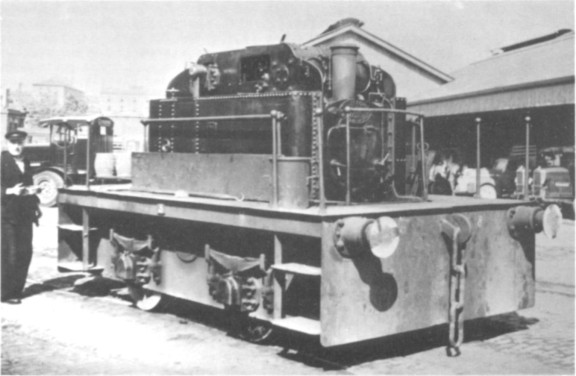
17 in one of the haulage wagons, 1947 (F. Jones).
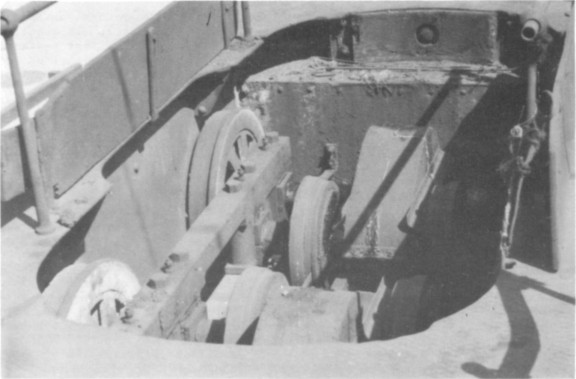
Bird’s-eye view of haulage wagon, taken 1955 (L. King).
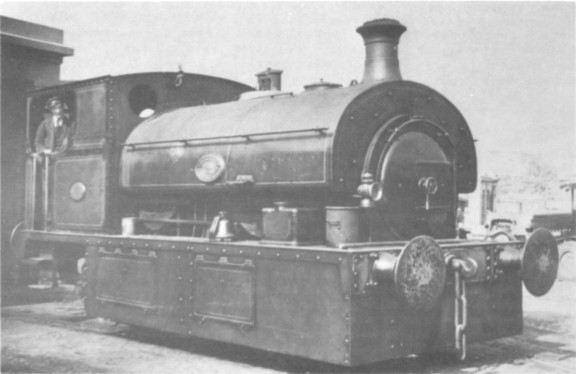
No.2 in 1947 (F. Jones).
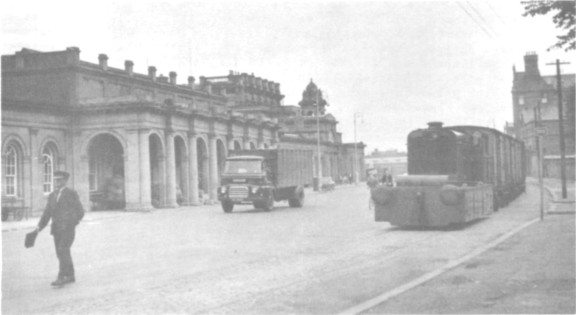
No.4 and train in the streets, 7th September 1960 (S. A. Leleux).
With regards to the orthodox broad gauge locomotives, the first was a short lived four wheeled petrol locomotive built by Messrs. Straker & Squire in 1912. It had a four cylinder engine unit of 90bhp output at 500rpm, transmission being by means of a Hele-Shaw clutch; in either direction there were four running speeds. A two cylinder compressor unit mounted on the footplate was driven by a 2½bhp petrol engine and this supplied compressed air for starting the main engine, and for the whistle. After giving considerable trouble in traffic, it was withdrawn from service in 1916 and finally went for scrap in 1921.
Broad gauge engines Nos.2 and 3 were a pair of Hudswell Clarke outside cylinder 0−4−0 saddle tanks, built in 1914 and 1919 respectively. Apart from each being fitted with a brass bell and having the motion and wheels enclosed for working through the Dublin streets, they were a standard design adapted for the 5ft 3in gauge. The leading dimensions were - cylinders 15in by 22in; wheel diameter aft 4in; boiler pressure 175 lbs per sq in; weight empty 24 tons. The most modern of the quartet of broad gauge locomotives was a Hudswell Clarke 0−4−0 diesel, No.4, named GUINNESS and built in 1949.
The broad gauge line is now no more, closed as the result of a road widening scheme. 0n Saturday morning, 15th May 1965, No.2 took the last train of vans to Rings bridge yard, and today the casks are taken there by lorry for trans-shipment into railway wagons. The narrow gauge system lingers on, although changing conditions since the Second World War have rendered parts obsolete in favour of other methods of transport. The narrow gauge network north of the marshalling yard, including the lines on the jetty in the lower part of the brewery, all closed in April 1961, but no major closures have taken place since then. Although this interesting brewery tramway will probably be eliminated in the not too distant future, it has served Guinness well and played a very important part in its success story.
I would like to express gratitude to the Engineer’s Department staff for rendering considerable assistance in the preparation of this article, and for checking its contents.
(We should be pleased to consider for publication, if available, photographs of the second and third narrow gauge locomotives and the broad gauge Straker-Squire petrol locomotive. - Hon. Eds.)
ABBREVIATIONS USED IN LOCOMOTIVE LIST
| D | - Diesel | ST | - Saddle Tank |
| HIW | - Haulage Wagon | T | - Side Tank |
| P | - Petrol | TG | - Tank loco, geared drive |
NARROW GAUGE LOCOMOTIVES
|
Number |
Name |
Type |
Builder |
Number |
Year |
Disposal |
| 1 | 0-4-0ST | Sharp, Stewart | 2477 | 1875 | Scrapped 1913 | |
| 2 | HOPS | 0-4-0TG | Stephen Lewin | 1876 | Scrapped 1914 | |
| 3 | MALT | 0-4-0TG | Stephen Lewin | 1876 | Scrapped 1927 | |
| 4 | 0-4-0T | Sharp, Stewart | 2764 | 1878 | Scrapped 1925 | |
| 5 | 0-4-0T | Sharp, Stewart | 2765 | 1878 | Scrapped 1925 | |
| 6 | 0-4-0T | Avonside | 1337 | 1882 | Withdrawn 1936, Scrapped 1947 | |
| 7 | 0-4-0T | Wm. Spence | 1887 | Scrapped 1948 | ||
| 8 | 0-4-0T | Wm. Spence | 1887 | Scrapped 1948 | ||
| 9 | 0-4-0T | Wm. Spence | 1887 | Scrapped 1949 | ||
| 10 | 0-4-0T | Wm. Spence | 1891 | Scrapped 1949 | ||
| 11 | 0-4-0T | Wm. Spence | 1891 | Scrapped 1949 | ||
| 12 | 0-4-0T | Wm. Spence | 1891 | Scrapped 1954 | ||
| 13 | 0-4-0T | Wm. Spence | 1895 | To Towyn Museum, Merioneth 1956 | ||
| 14 | 0-4-0T | Wm. Spence | 1895 | Scrapped 1951 | ||
| 15** | 0-4-0T | Wm. Spence | 1895 | Withdrawn 1957, preserved | ||
| 16 | 0-4-0T | Wm. Spence | 1902 | Scrapped 1951 | ||
| 17 | 0-4-0T | Wm. Spence | 1902 | Withdrawn 1962, preserved on site | ||
| 18 | 0-4-0T | Wm. Spence | 1902 | Scrapped 1951 | ||
| 19 | 0-4-0T | Wm. Spence | 1902 | Scrapped 1951 | ||
| 20 | 0-4-0T | Wm. Spence | 1905 | To Belfast Museum, 1956 | ||
| 21*** | 0-4-0T | Wm. Spence | 1905 | Withdrawn 1959 | ||
| 22*** | 0-4-0T | Wm. Spence | 1912 | Withdrawn 1957 | ||
| 23 | 0-4-0T | Wm. Spence | 1921 | To Brockham Museum, Surrey 1966 | ||
| 24 | 0-4-0T | Wm. Spence | 1921 | Retained for preservation | ||
| 25 | 4wD | F.C.Hibberd | 3068 | 1947 | ||
| 26 | 4wD | F.C.Hibberd | 3255 | 1948 | ||
| 27 | 4wD | F.C.Hibberd | 3256 | 1948 | ||
| 28 | 4wD | F.C.Hibberd | 3257 | 1948 | Withdrawn 1961 | |
| 29 | 4wD | F.C.Hibberd | 3258 | 1948 | ||
| 30 | 4wD | F.C.Hibberd | 3259 | 1948 | Withdrawn 1961 | |
| 31 | 4wD | F.C.Hibberd | 3446 | 1950 | ||
| 32 | 4wD | F.C.Hibberd | 3444 | 1950 | ||
| 33 | 4wD | F.C.Hibberd | 3445 | 1950 | Withdrawn 1961 | |
| 34 | 4wD | F.C.Hibberd | 3448 | 1950 | ||
| 35 | 4wD | F.C.Hibberd | 3449 | 1950 | ||
| 36* | 4wD | F.C.Hibberd | 3447 | 1950 |
* Delivered in 1951 after being exhibited at the Festival of Britain.
** Presented to the Irish Steam Preservation Society; present location not known
*** Noted out of use at the Brewery in August 1965.
BROAD GAUGE LOCOMOTIVES
| 1 | 4wHW | Wm. Spence | 1888 | |||
| 2 | 4wHW | Wm. Spence | 1888 | |||
| 3 | 4wHW | Wm. Spence | 1893 | |||
| 4 | 4wHW | Wm. Spence | 1903 | To Brockham Museum, Surrey, 1966 | ||
| 1 | 4wP | Straker-Squire | 1912 | Withdrawn 1916, Scrapped 1921 | ||
| 2 | 0-4-0ST | Hudswell Clarke | 1079 | 1914 | Scrapped 1965 | |
| 3+ | 0-4-0ST | Hudswell Clarke | 1152 | 1919 | Preserved | |
| 4 | 0-4-0D | Hudswell Clarke | D700 | 1949 | Scrapped, June 1966 |
+ Presented to the Railway
Preservation Society of Ireland, 1965.
(Present location: Whitehead Depot, Co.
Antrim)